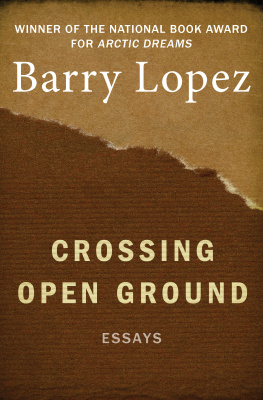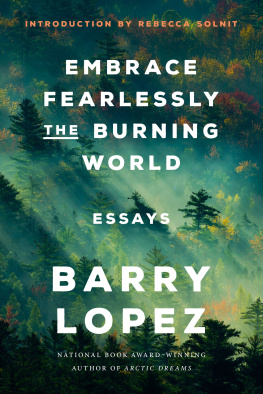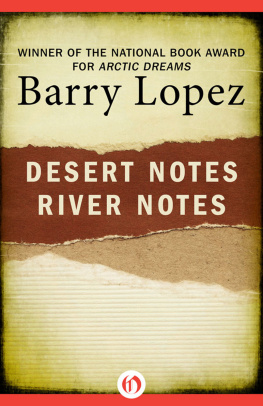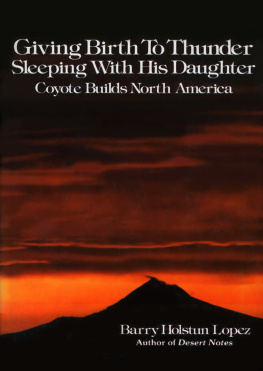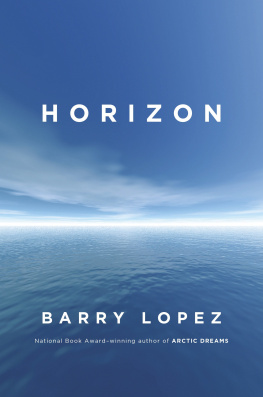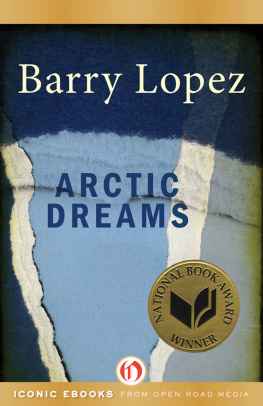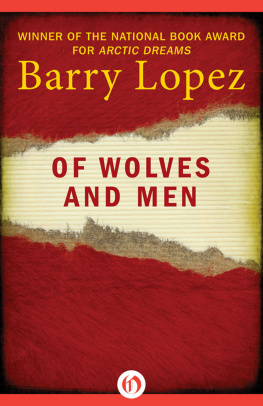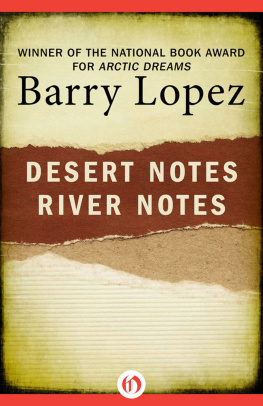BARRY LOPEZ
FROM OPEN ROAD MEDIA
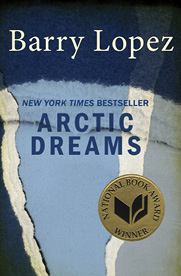

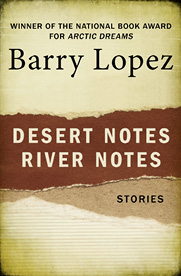
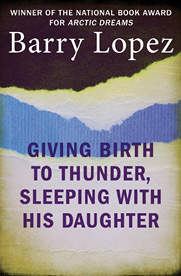

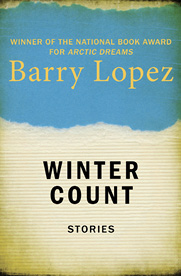


Find a full list of our authors and
titles at www.openroadmedia.com
FOLLOW US
@OpenRoadMedia



Crossing Open Ground
Essays
Barry Lopez

To the men and women with whom Ive traveled and to the editors with whom Ive worked, especially L. S.
The Stone Horse
THE DESERTS OF SOUTHERN California, the high, relatively cooler and wetter Mojave and the hotter, dryer Sonoran to the south of it, carry the signatures of many cultures. Prehistoric rock drawings in the Mojaves Coso Range, probably the greatest concentration of petroglyphs in North America, are at least three thousand years old. Big game hunting cultures that flourished six or seven thousand years before that are known from broken spear tips, choppers, and burins left scattered along the shores of great Pleistocene lakes, long since evaporated. Weapons and tools discovered at China Lake may be thirty thousand years old; and worked stone from a quarry in the Calico Mountains is, some argue, evidence that human beings were here more than two hundred thousand years ago.
Because of the long-term stability of such arid environments, much of this prehistoric stone evidence still lies exposed on the ground, accessible to anyone who passes bythe studious, the acquisitive, the indifferent, the merely curious. Archaeologists do not agree on the sequence of cultural history beyond about twelve thousand years ago, but it is clear that these broken bits of chalcedony, chert, and obsidian, like the animal drawings and geometric designs etched on walls of basalt throughout the desert, anchor the earliest threads of human history, the first record of human endeavor here.
Western man did not enter the California desert until the end of the eighteenth century, 250 years after Coronado brought his soldiers into the Zuni pueblos in a bewildered search for the cities of Cibola. The earliest appraisals of the land were cursory, hurried. People traveled through it, en route to Santa Fe or the California coastal settlements. Only miners tarried. In 1823 what had been Spains became Mexicos and in 1848 what had been Mexicos became Americas; but the bare, jagged mountains and dry lake beds, the vast and uniform plains of creosote bush and yucca plants, remained as obscure as the northern Sudan until the end of the nineteenth century.
Before 1940 the tangible evidence of twentieth-century mans passage here consisted of very littlethe hard tracery of travel corridors; the widely scattered, relatively insignificant evidence of mining operations; and the fair expanse of irrigated fields at the deserts periphery. In the space of a hundred years or so the wagon roads were paved, railroads were laid down, and canals and high-tension lines were built to bring water and electricity across the desert to Los Angeles from the Colorado River. The dark mouths of gold, talc, and tin mines yawned from the bony flanks of desert ranges. Dust-encrusted chemical plants stood at work on the lonely edges of dry lake beds. And crops of grapes, lettuce, dates, alfalfa, and cotton covered the Coachella and Imperial valleys, north and south of the Salton Sea, and the Palo Verde Valley along the Colorado.
These developments proceeded with little or no awareness of earlier human occupations by cultures that preceded those of the historic Indiansthe Mohave, the Chemehuevi, the Quechan. (Extensive irrigation began to actually change the climate of the Sonoran Desert, and human settlements, the railroads, and farming introduced many new, successful plants and animals into the region.)
During World War II, the American military moved into the desert in great force, to train troops and to test equipment. They found the clear weather conducive to year-round flying, the dry air, and isolation very attractive. After the war, a complex of training grounds, storage facilities, and gunnery and test ranges was permanently settled on more than three million acres of military reservations. Few perceived the extent or significance of the destruction of aboriginal sites that took place during tank maneuvers and bombing runs or in the laying out of highways, railroads, mining districts, and irrigated fields. The few who intuited that something like an American Dordogne Valley lay exposed here were (only) amateur archaeologists; even they reasoned that the desert was too vast for any of this to matter.
After World War II, people began moving out of the crowded Los Angeles basin into homes in Lucerne, Apple, and Antelope valleys in the western Mojave. They emigrated as well to a stretch of resort land at the foot of the San Jacinto Mountains that included Palm Springs, and farther out to old railroad and military towns like Twentynine Palms and Barstow. People also began exploring the desert, at first in military-surplus jeeps and then with a variety of all-terrain and off-road vehicles that became available in the 1960s. By the mid-1970s, the number of people using such vehicles for desert recreation had increased exponentially. Most came and went in innocent curiosity; the few who didnt wreaked a havoc all out of proportion to their numbers. The disturbance of previously isolated archaeological sites increased by an order of magnitude. Many sites were vandalized before archaeologists, themselves late to the desert, had any firm grasp of the bounds of human history in the desert. It was as though in the same moment an Aztec library had been discovered intact various lacunae had begun to appear.
The vandalism was of three sorts: the general disturbance usually caused by souvenir hunters and by the curious and the oblivious; the wholesale stripping of a place by professional thieves for black-market sale and trade; and outright destruction, in which vehicles were actually used to ram and trench an area. By 1980, the Bureau of Land Management estimated that probably thirty-five percent of the archaeological sites in the desert had been vandalized. The destruction at some places by rifles and shotguns, or by power winches mounted on vehicles, was, if one cared for history, demoralizing to behold.

